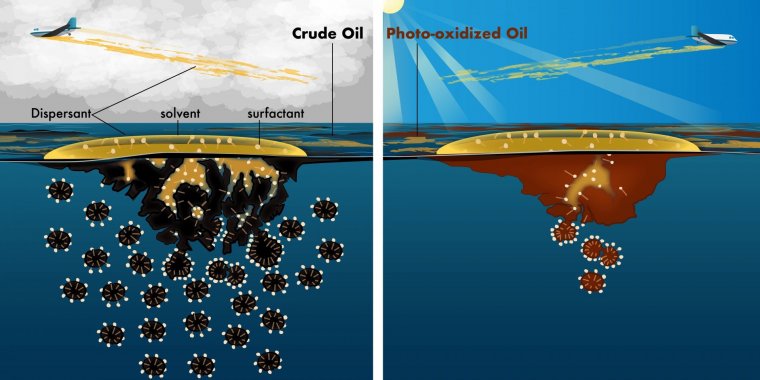| News / Science News |
Sunlight reduces effectiveness of dispersants used to clean up oil spills
A new study shows that sunlight transforms oil spills on the ocean surface more quickly and significantly than previously thought, limiting the effectiveness of chemical dispersants that break up floating oil.

Sunlight changes how well oil dispersants work on spills such as the 2010 Deepwater Horizon disaster. Image credit: WHOI
A research team led by the Woods Hole Oceanographic Institution (WHOI) found that sunlight changes oil into different compounds that dispersants cannot easily break up. The findings could affect how responders decide when, where and how to use dispersants.
Dispersants contain detergents, not unlike those people use to wash dishes, which help break oil into small droplets that are diluted in the ocean or are eaten by microbes before the oil can be swept to sensitive coastlines.
But to do their work, the detergents (also known as surfactants) first need to mix with both the oil and water -- and oil and water, famously, don't mix.
To overcome this barrier, dispersants contain an organic solvent that helps the oil, detergents and water mix. Only when this step happens can the surfactants do their work to break oil into droplets. But sunlight obstructs this step, the new study shows.
Before dispersants can be applied, light energy from the sun immediately begins to break chemical bonds in oil compounds -- splitting off atoms or chemical chains and creating openings for oxygen to attach.
This photo-oxidation process (also known as photochemical "weathering") is similar to the process that causes paint on cars or colors on clothes to fade if they are left out in the sun for too long.
To date, tests to determine the effectiveness of dispersants used only "fresh" oil that hadn't been altered by sunlight. In the new study, the researchers conducted extensive lab tests exposing oil to sunlight.
They showed that sunlight rapidly transforms oil into residues that are only partially soluble in a dispersant's solvent, limiting the ability of detergents to mix with the photo-oxidized oil and break the oil into droplets.
The finding suggests that responders should factor in sunlight when determining the "window of opportunity" to use dispersants effectively. That window is far smaller on sunny days than previously thought.
Results of the experiments showed that light rapidly photo-oxidized the fresh oil, changing it within a few days into compounds that reduced the effectiveness of dispersants by at least 30 percent.
The results showed that because they targeted photochemically-weathered oil, the majority of dispersant applications would not have achieved minimum effectiveness levels under average wind and sunlight conditions. (National Science Foundation)
YOU MAY ALSO LIKE




